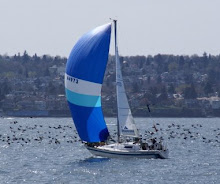 So where are all the bees??? Well, I've seen a few around both wild bees and the odd honeybee but not any where as many as I remember seeing back in the 1960s in southwestern Ontario. Up until I sold my house in London I had a garden with plenty of flowers and various bees, butterflies and hoverflies to go along with them. The garden was alive with flying insects of one sort or another from the time things warmed up in the spring until the snow started flying in late autumn. The bees had lots of nectar from spring and summer heather, scotch broom, genista, roses, thyme, veronica, perennial cornflower, false indigo and many other flowers. Then I didn't use insecticide, herbicides and pesticides on any of my plants but rather organic methods more environmentally friendly than those sprays mentioned. So that meant pulling weeds by hand and companion planting instead. This means more work but it's better for the environment and all the creatures that live in it in the long run!
So where are all the bees??? Well, I've seen a few around both wild bees and the odd honeybee but not any where as many as I remember seeing back in the 1960s in southwestern Ontario. Up until I sold my house in London I had a garden with plenty of flowers and various bees, butterflies and hoverflies to go along with them. The garden was alive with flying insects of one sort or another from the time things warmed up in the spring until the snow started flying in late autumn. The bees had lots of nectar from spring and summer heather, scotch broom, genista, roses, thyme, veronica, perennial cornflower, false indigo and many other flowers. Then I didn't use insecticide, herbicides and pesticides on any of my plants but rather organic methods more environmentally friendly than those sprays mentioned. So that meant pulling weeds by hand and companion planting instead. This means more work but it's better for the environment and all the creatures that live in it in the long run!So back to the bees in the Greater Vancouver area. Both Wednesday and Thursday I paid a visit to Hawthorne Rotary Park and Bear Creek Park in Surrey. There were some wild bees but few of them and they seemed to be skittish. I haven't seen any honeybees lately. The last one I saw was about a week or two ago. This series of photos show a bumblebee on a perennial cornflower, Centaurea montana, taken at Bear Creek Park on Thursday afternoon. This is a solitary wild bee going from one flower to another in search of nectar. I did see another couple of bumblebees around a planting of rhododendrons but they made themselves scarce. No honeybees were spotted at either park or enroute between them. Well, enjoy seeing this one anyway!




Here's a little further information on the perennial cornflower, Centaurea montana. Go to Wikipedia.org for more details on this species and the more than 350 - 500 species found in the world.
Centaurea montana (common names include perennial cornflower, mountain cornflower and mountain bluet) is a species of Centaurea endemic to Europe. It is widespread and common in the more southerly mountain ranges of Europe, but is rarer in the north. It escapes from gardens readily, and has thereby become established in the British Isles, Scandinavia and North America.
C. montana grows in meadows and open woodland in the upper montane and sub-alpine zones, in basic areas. It grows to 30–70 cm (12–28") tall, and flowers mainly from May to August.
A flower head of C. montana seen from above
C. montana may be distinguished from other Centaurea species in the region by its usually entire leaves, and the blue-purple colour of the outermost ray florets. It may be distinguished from the cornflower, C. cyanus, by having a single (rarely up to three) flower heads, and by its being perennial, whereas the cornflower has many flower heads and is annual. The closely-related C. triumfettii has more narrowly-winged stems, narrower leaves and grows in rockier areas.

No comments:
Post a Comment